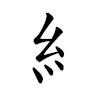糸
From Wiktionary, the free dictionary
| ||||||||
| ||||||||
Translingual
Alternative forms
Han character
糸 (Kangxi radical 120, 糸+0, 6 strokes, cangjie input 女戈火 (VIF), four-corner 22903, composition ⿱幺小)
- Kangxi radical #120, ⽷.
- Shuōwén Jiězì radical №467
Derived characters
References
- Kangxi Dictionary: page 915, character 1
- Dai Kanwa Jiten: character 27221
- Dae Jaweon: page 1341, character 36
- Hanyu Da Zidian (first edition): volume 5, page 3361, character 1
- Unihan data for U+7CF8
Usage notes
When used as a radical component on the left, Japanese Kanji and Korean Hanja use a compressed form of 糸 (with 小 on the bottom, but the centre 亅 stroke in 小 is written as 丨 without the bottom hook), which is also the historical form found in the Kangxi dictionary. In traditional Chinese and Vietnamese chữ Hán, the standard written form of the radical is 糹 (with three dots on the bottom), while in simplified Chinese the radical is written 纟.
Chinese
Glyph origin
| Historical forms of the character 糸 | ||||
|---|---|---|---|---|
| Shang | Western Zhou | Shuowen Jiezi (compiled in Han) | ||
| Bronze inscriptions | Oracle bone script | Bronze inscriptions | Ancient script | Small seal script |
 |
 |
 |
 |
 |
Etymology 1
Pronunciation
- Mandarin
- (Standard Chinese)+
- Hanyu Pinyin: mì
- Zhuyin: ㄇㄧˋ
- Tongyong Pinyin: mì
- Wade–Giles: mi4
- Yale: mì
- Gwoyeu Romatzyh: mih
- Palladius: ми (mi)
- Sinological IPA (key): /mi⁵¹/
- (Standard Chinese)+
- Cantonese
- (Standard Cantonese, Guangzhou–Hong Kong)
- Jyutping: mik6
- Yale: mihk
- Cantonese Pinyin: mik9
- Guangdong Romanization: mig6
- Sinological IPA (key): /mɪk̚²/
- (Standard Cantonese, Guangzhou–Hong Kong)
- Hakka
- (Sixian, incl. Miaoli and Neipu)
- Pha̍k-fa-sṳ: mi̍t
- Hakka Romanization System: mid
- Hagfa Pinyim: mid6
- Sinological IPA: /mit̚⁵/
- (Sixian, incl. Miaoli and Neipu)
- Wu
- Middle Chinese: mek
- Old Chinese
- (Zhengzhang): /*meːɡ/
Definitions
糸
- (obsolete on its own in Standard Chinese) thin silk
- (obsolete on its own in Standard Chinese) A length unit, equal to the width of five parallel threads of silk.
Etymology 2
| For pronunciation and definitions of 糸 – see 絲 (“silk; thread; thread/silk-like objects; string; thin strip; thin shred; etc.”). (This character is a variant form of 絲). |
Japanese
| 糸 | |
| 絲 |
Kanji
糸
(First grade kyōiku kanji, shinjitai kanji, kyūjitai form 絲)
Readings
As unsimplified kanji 糸:
As shinjitai kanji of 絲:
Compounds
Etymology
| Alternative spelling |
|---|
| 絲 (kyūjitai) |
From Old Japanese, from Proto-Japonic *ito.
Noun
Derived terms
Derived terms
- 糸屑 (itokuzu)
- 糸口 (itoguchi)
- 糸繰 (itokuri)
- 糸車 (itoguruma)
- 糸雨 (itosame)
- 糸杉 (itosugi)
- 糸電話 (itodenwa)
- 糸蜻蛉 (itotonbo)
- 糸偏 (itohen)
- 糸巻 (itomaki)
- 糸リフト (itorifuto)
- 糸枠 (itowaki)
- 赤い糸 (akai ito)
- 麻糸 (asaito)
- 渦糸 (uzuito)
- 紙糸 (kamīto)
- 生糸 (kīto)
- 絹糸 (kinuito)
- 毛糸 (keito)
- 白糸 (shiraito)
- 縦糸, 経糸 (tateito)
- 釣り糸 (tsuri-ito)
- 天蚕糸 (teguito)
- 結び糸 (musubi-ito)
- 山繭糸 (yamamayuito)
- 横糸, 緯糸 (yokoito)
See also
Korean
Hanja
糸 (eumhun 가는 실 멱 (ganeun sil myeok))
- This term needs a translation to English. Please help out and add a translation, then remove the text
{{rfdef}}.
Okinawan
Kanji
糸
Readings
Etymology
| Alternative spelling |
|---|
| 絲 (kyūjitai) |
Noun
糸 (īchū)
Vietnamese
Chữ Hán
- This term needs a translation to English. Please help out and add a translation, then remove the text
{{rfdef}}.
References
Wikiwand - on
Seamless Wikipedia browsing. On steroids.

